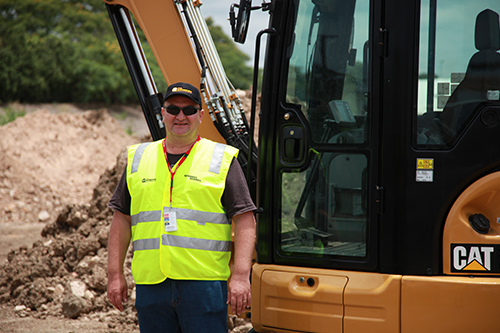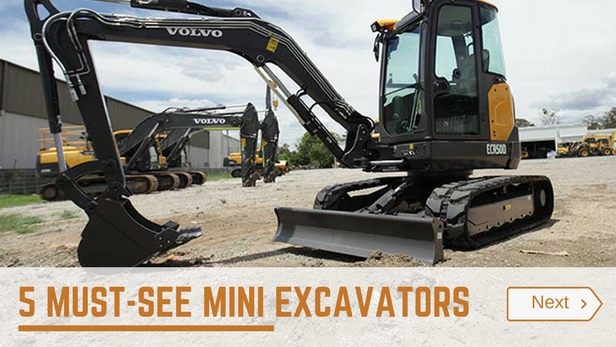At a glance Cat excavators might not look as though they’ve changed much over the years, but they’re packed with innovation, as EVARN COVICH discovered when he took the 5.1-tonne 305E2 compact radius excavator for a test run recently.
Caterpillar has forged more than a solid reputation over 90 years of making earthmoving equipment but it doesn’t rest on its laurels and still has the capability to surprise us with its innovations.
This was the case recently when I had the opportunity to operate a Cat 305E2 compact radius excavator at the Hastings Deering testing ground in Brisbane.
From the Complete, Operation, Maintenance, Performance and Security System (COMPASS) to the 200-degree bucket rotation for enhanced spoil retention while loading trucks, and the new High Definition Hydraulic (HDH) system available on the new E2 range of excavators, Cat has addressed some of the issues that have long plagued excavator owners and operators.
These US-manufactured excavators are also available with an array of buckets and attachments that Cat has designed to suit each particular machine in order to maximise productivity and efficiency.
Watch Evarn’s Cat 305E2 excavator video here!
Walk around
The welding construction of the Cat 305E2 looks to be sturdy and neat, and the body — including the rear engine door, the side hydraulic system and radiator cover — is constructed from steel.
Peering in through the rear engine door it is good to see that even though there is not much room, as you would expect with any short radius machine, it is still easy to access the engine oil dipstick and filler as well as the window washer bottle.
It is also good to see that the exhaust has been positioned to blow out through the top-rear of the machine. Some short-radius machines blow out directly through the rear, affecting anyone who may be working in the vicinity at the time. (There’s nothing like getting a lung full of diesel fumes while you’re standing in a trench trying to get levels.)
Filler points, filters and sample-taking ports are also easily accessible via the side cover.
The factory ROPS, TOPS and FOPS cab, with a headlight on top, looks to be well constructed and auxiliary piping, bucket linkage lifting eye and thumb-ready stick-mounted brackets come as standard for the Australian market.
Engine
Cat says it has equipped the E2 range of excavators with power plants that best match performance and power to machine weight and application in order. This machine runs a four-cylinder Cat C2.4 engine which produces 40.2 horsepower (30kW) and meets US Tier 4 Interim/EU Stage IIIA emission standards.
Tracks
The track frame is angled on top to help alleviate dirt buildup which we all know can be a hard job to clean out once it gets compacted in there and can also affect the track performance. The frame is also equipped with tie down eyes to make for easier securing while transporting. The machine comes standard with rubber tracks but is also available with optional steel tracks and optional rubber pads can also be attached to steel tracks as well for extra versatility.
Hydraulics
The new HDH system mentioned above uses a load-sensing variable piston pump and flow-sharing capability to improve control, precision and performance, according to Cat. The simple valve architecture in the HDH system reduces heat in the oil, leading to better hydraulic performance and efficiency.
With hydraulic oil samples being taken from the easily accessible sample ports during a service, a 3000-hour hydraulic oil change can be pushed out up to 6000 hours if all is clear.
Hydraulic hoses are tagged with part numbers for easy identification, and also have a QR code you can scan with your smartphone.
Auxiliary lines with quick connections come as standard on these machines. A standard accumulator allows the pressure to be released from the lines when changing implements in order to make the job easier and safer. Also, if you happen to run out of fuel you can also use the accumulator to lower your implement to the ground if it is stranded in the air.
 |
|
The 305E2’s enclosed cabin makes for a nice, quiet and cool work environment.
|
In the cab
Climbing into the Cat 305E2’s redesigned ROPS, TOPS and FOPS cab is fairly easy because the company has gone for a hinged cabin door instead the sliding doors on earlier models, which affords larger operators like me more room when mounting and dismounting.
The auxiliary controls have been moved from the floor into the operation control levers, and settling into the driver seat I immediately notice that this gives more leg room.
The adjustable suspension seat coupled with well-positioned, adjustable armrests allows me to quickly get myself into a comfortable operating position. The armrests are able to be reversed if you would prefer to have the pads positioned under your wrists.
Controls
The control levers feel comfortable to hold. Each has a rolling switch, with the left hand controlling the boom pivot and the right hand operating the auxiliary lines to your attachment.
I like this as I feel that tilt buckets and the like are a lot easier to control with the hands as opposed to the feet, and equates to better production.
The switches and dials inside the cabin are pretty self-explanatory and easily accessible, but are also rather scarce because many of the features that are switch-controlled are now operated through the new COMPASS control panel.
A USB port linked to the radio and a power supply are also situated near the operator’s left elbow so you can listen to your favourite tunes and keep that phone charged.
Visibility
The windows on the Cat 305E2 give excellent vision around the whole machine. The glass in the bottom of the front window can slide up into the main window before sliding the whole unit up to the roof. This neatly eliminates the age-old problem of where to store the bottom front glass on a short-radius digger.
Climate control
It was nearing a humid 32 degrees on the day of our test so when I got inside and started up the machine the aircon was quickly placed on three. After only a few minutes I was able to wind it back to one in order to maintain a comfortable temperature for the test.
COMPASS control panel
This control panel has been designed by Cat specifically for compact excavators and is available throughout the E2 range of machines. The LED display gives the operator the usual dash requirements such as engine temperature and fuel level along with performance and maintenance information.
A five-digit alphanumeric password must be entered before the operator is able to start the machine. Five codes can be generated for use by different operators as well as a master password for the owner. No more worrying about anyone with a Cat key operating your machine on site without your permission!
The adjustable auxiliary flow control allows the operator to adjust the oil flow rate through 15 settings in order to optimise implement performance. A continuous-flow feature also allows the operator to hold the auxiliary roller switch on the right hand joystick at a certain flow rate for 2.5 seconds and the machine will maintain that flow rate until it has been turned off.
The control lever pattern changer is also activated through the panel, enabling the operation pattern to be changed between excavator and backhoe at the push of a button. The quick hitch is also operated through the panel.
 |
|
Reviewer Evarn Covich with the Cat 305E2 excavator.
|
On the job
We had a few stockpiles of dirt and rock at the Hastings Deering test area in Acacia Ridge in Brisbane.
On startup the enclosed cabin made for a nice, quiet and cool work environment. I cranked up the AM/FM stereo to help me get into my rhythm and was pleasantly surprised with the sound quality.
I turned up the revs and walked the machine up onto a bench of overburden. The two-speed travel worked well, with the machine moving along at a good pace before the incline became too much and then kicking down into low gear.
It climbed the face of the spoil without too much effort at all and also without the need to place the bucket in the ground to pull the machine up.
As I started to dig through the pile of overburden I was impressed by the stability and smooth operation of the machine. It seemed to cut through the stockpiled material and throw it around with relative ease so after a while I dropped the machine back down to ground level and started digging some of the compacted roadway in order to get the Cat working harder.
I cut through the upper levels of roadbase in order to get to the harder virgin ground. Even then, although the machine was working harder it still performed very well.
I lifted some full buckets of dirt as high in the air as the machine would allow in order to test the 200-degree bucket rotation. Even with the arm out at full stretch I was able to keep the majority of the dirt inside the bucket, which will help production when loading larger trucks, etc.
The bucket is able to curl out further as well, which makes it easier to trim walls and the like.
The dozer blade is positioned pretty well with good visibility from the cab, and the Cat 305E2 excavator was able to push around a full blade of dirt with relative ease.
The float function can also help achieve a better finish when pushing dirt around the site, so no more excuses about the bad finish! These machines are also available with an angle-blade option for a bit more versatility.
The bottom line
Although to the naked eye it might look as though modern Cat excavators haven’t changed a great deal over the years, it is good to see that the company is investing time and money into improving the operating systems of its smaller machines.
Among the features I liked of the Cat 305E2 excavator were the lack of foot pedals, a longer bucket stroke to make for easier wall cleaning and truck loading, and the new COMPASS control panel. But my favourite is the passcode-activated security system.
I found the 305E2 to be comfortable and stable to operate, and the new hydraulic system gave the feeling of fast yet smooth operation with good breakout power.
Add auxiliary hydraulic lines with quick connects, certified lifting eye on the bucket linkage, thumb-ready mounts on the stick arm, up to 20 percent fuel saving and longer intervals between services, and the Cat 305E2 excavator looks like a pretty good long-term investment.
Photography: Nic Leggat







